The Definition of Hypergranulation
- Granulation tissue – new connective tissue that is formed during the process of wound healing:
- Hypergranulation;
- Overgranulation;
- Exuberant granulation tissue;
- “Proud flesh.”
- Hypergranulation – “an excess of granulation tissue that fills the wound bed to a greater extent than what is required and goes beyond the height of the surface of the wound resulting in a raised tissue mass” (Jaeger et al., 2016, p. 241).
During the stage of wound proliferation, the formation of healthy granulation tissue becomes central to proper wound healing. In the majority of cases, the process of granulation occurs without significant challenges, but it is not always the case (Brown, 2019). You might have heard some of the four terms listed on the slide – all of them are used to define a specific problem that we will be discussing today. Basically, hypergranulation occurs when the amount of granulation tissue is far beyond what is required to replace the deficit of tissue associated with the wound. The formation of shiny and red tissue that rises above the surrounding skin and often bleeds easily is what can be observed in the cases of hypergranulation (Jaeger et al., 2016).
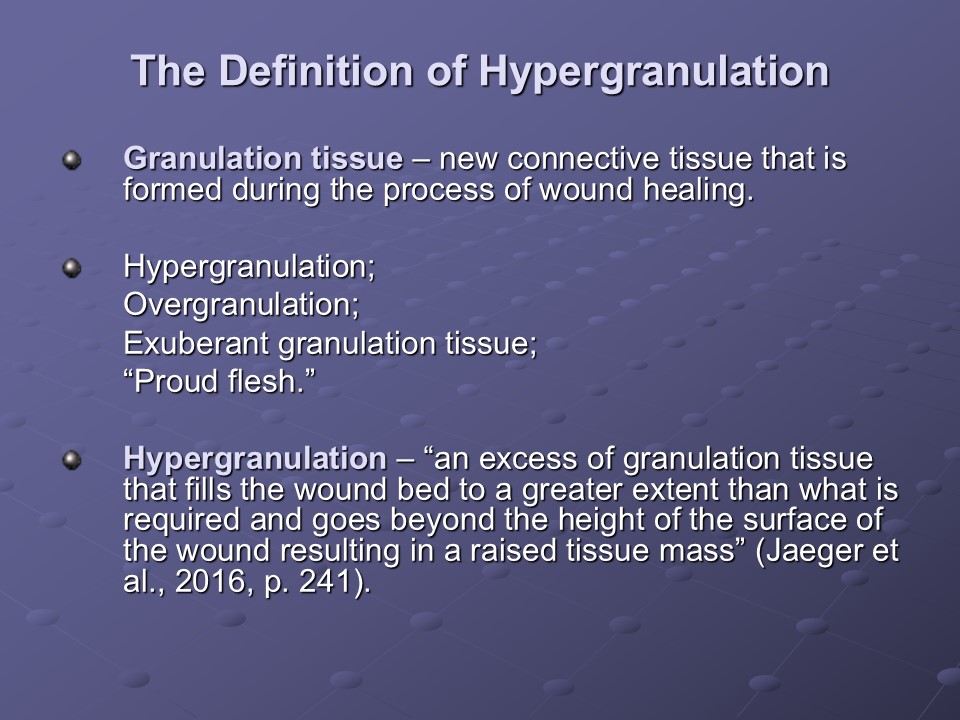
Suggested Causes of Hypergranulation
- The main cause of hypergranulation is currently underresearched;
- A popular suggestion: an imbalance of matrix metalloproteinases (MMPs) during the third stage of healing (proliferation) causes hypergranulation (Brown, 2019).
Currently, there is no general consensus on the key cause of hypergranulation, but a widely supported opinion is that the issue has to deal with an imbalance of matrix metalloproteinases during the stage of wound proliferation (Brown, 2019; Jaeger et al., 2016). MMPs are enzymes that degrade proteins and help to maintain the right balance between the normal formation of collagen and the reabsorption of what is called the extracellular matrix – a network of macromolecules that supports surrounding cells (Brown, 2019). Due to this imbalance, as it is supposed, the production of collagen becomes uncontrolled, which contributes to the formation of abnormal granulation tissue (Brown, 2019).
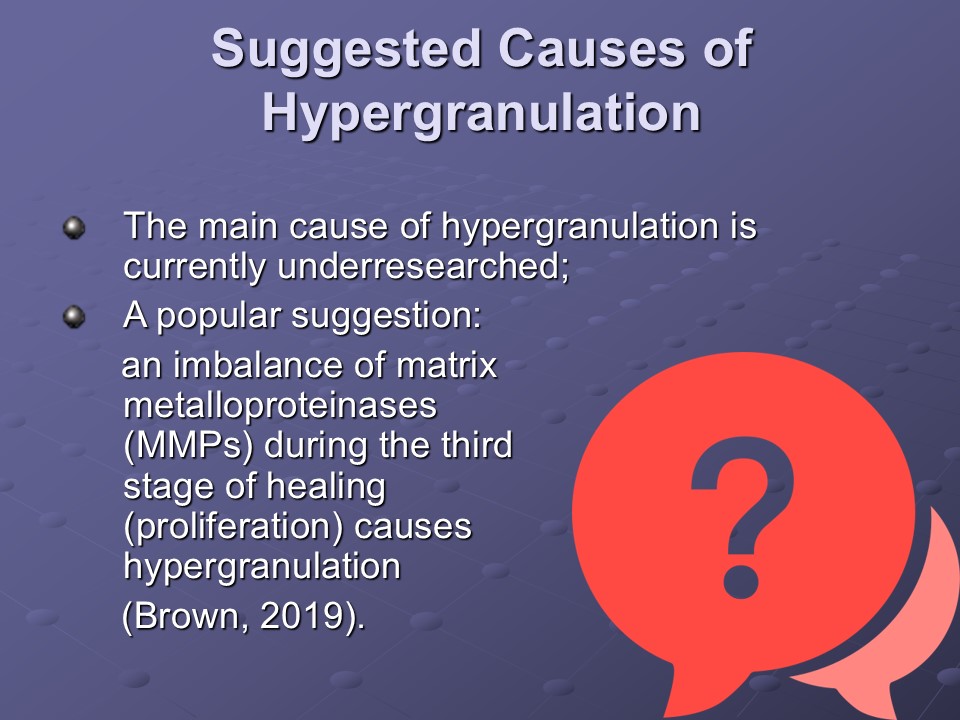
Hypergranulation and How It Affects Patients
- Delayed wound healing;
- Challenges surrounding the process of re-epithelialization and wound closure (Jaeger et al., 2016; Prado, Nichols, & Zaiac, 2018);
- Poor cosmetic appearance of wounds (Waldman, Lin, & Sloan, 2019);
- Risks of secondary infections and excessive wound drainage (Hirotsu, Kannan, & Jiang, 2019).
The complication in question negatively affects patients in multiple ways. Most importantly, it increases the amount of time needed for wound healing, which is challenging for both patients and healthcare providers. Hypergranulation is a barrier to wound closure and maturation since the excessive granulation tissue impedes the proper migration of epithelial cells across the wound (Jaeger et al., 2016). The presence of excessive granulation tissue at the wound site impairs the process of re-epithelialization since epithelial cells are basically urged to migrate vertically (Prado et al., 2018). More than that, overgranulation is widely associated with patient discomfort and poor wound cosmesis outcomes or the presence of unsightly scars after healing, which can result in psychological issues (Waldman et al., 2019). Next, the formation of excessive granulation tissue is closely associated with secondary infections, the excessive production of wound exudate, and skin maceration (Hirotsu et al., 2019).
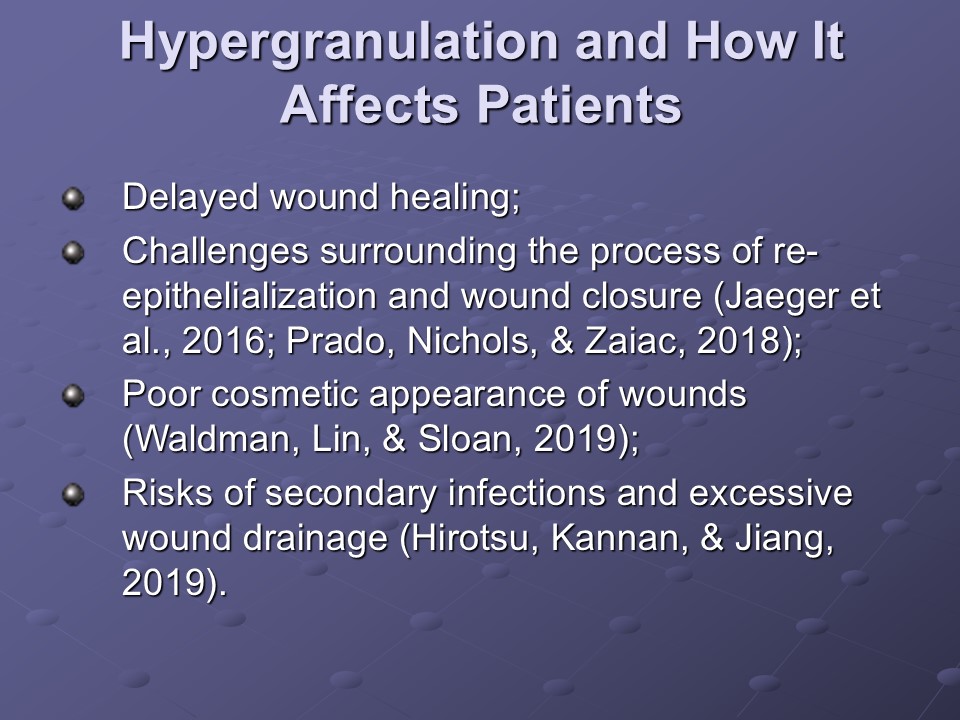
Hypergranulation and Affected Populations
- Overgranulation is frequently reported in burn survivors – 10% to 17% (Jaeger et al., 2016, p. 242); 10% to 15% (Hirotsu et al., 2019, p. 1507).
- It affects 25% – 68% of patients who receive long-term enteral nutrition (Ae, Kosami, & Yahata, 2016, p. 53; Hirotsu et al., 2019, p. 1507).
- Case studies report hypergranulation in patients with chronic post-surgical wounds, pressure ulcers, and venous ulcers, but the exact incidence is uncertain (Hirotsu et al., 2019; Waldman et al., 2019).
And now, let’s talk about what is known about the incidence of hypergranulation tissue in patients with different types of wounds. As you can see, evidence from modern scientific literature suggests that proud flesh affects up to 17% of people with burn wounds, but it is much more common in patients from different age groups that receive enteral nutrition (Ae et al., 2016; Jaeger et al., 2016; Hirotsu et al., 2019).
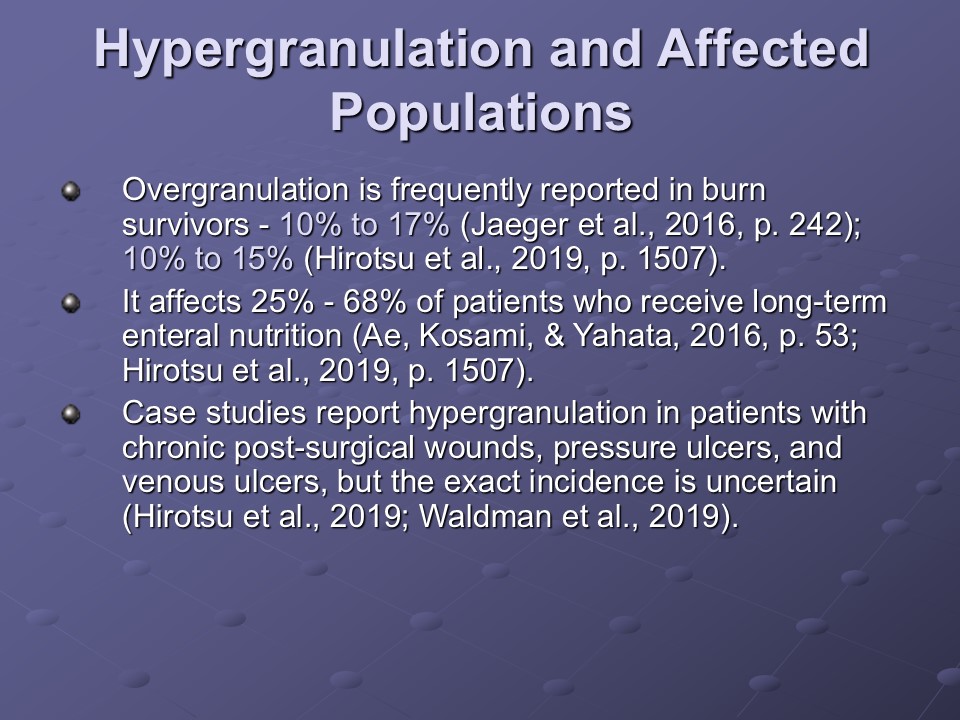
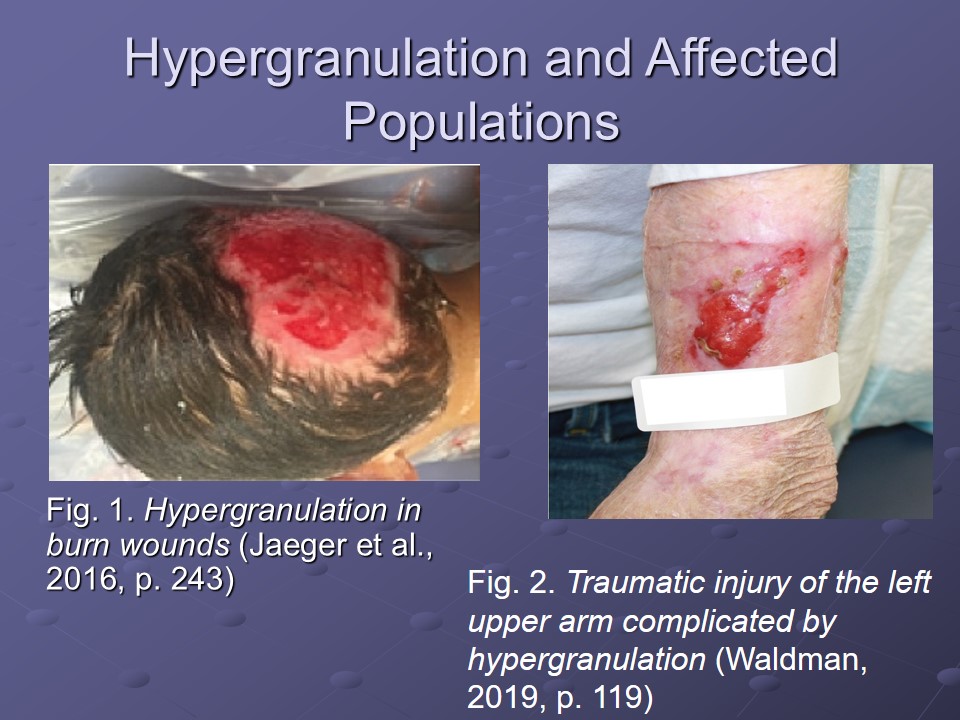
Predisposing Factors to Hypergranulation
- Secondary intention healing is associated with the increased risks of hypergranulation (Brown, 2019);
- Excessive moisture at the wound site (Brown, 2019; Hirotsu et al., 2019).
- Inflammatory stage of wound healing takes too much time (Brown, 2019; Hirotsu et al., 2019);
- The prolonged inflammatory phase can be caused by different infections and elevated levels of bacteria in the wound site (Brown, 2019; Hirotsu et al., 2019).
- Friction on the wound contributes to overgranulation and topical inflammation (Ae et al., 2016);
- In gastrostomy tube patients, overgranulation is often associated with tube friction (Ae et al., 2016);
- Persistent irritants and allergic reactions (Brown, 2019).
- It is supposed that hydrocolloid dressings may contribute to the risks of hypergranulation by causing wound hypoxia (Brown, 2019; Hirotsu et al., 2019);
- Potential risk factors: the use of retinoids, immunosuppressant medications, and epidermal growth factor inhibitors (Sechi et al., 2019).
Now, I would like to discuss the various factors that are believed to increase the risks of overgranulation in different types of patients. The first important factor is the presence of wounds that heal by secondary intention, which means that the wound’s edges cannot be sutured, so it has to be left open to be healed by granulation (Brown, 2019). Next, the extra moisture in the area around the wound or on its surface is also supposed to increase the risks of hypergranulation, which is why measures for balancing moisture are considered helpful (Brown, 2019; Hirotsu et al., 2019). The selected measures should, of course, be chosen depending on the type of wound and after a holistic analysis of patients’ needs.
To continue, it is widely supposed that the risks of overgranulation are related to the length of the inflammatory stage of wound healing. In wounds resulting from injuries, the inflammatory phase occurs right after the injury, but it sometimes takes extra time due to the presence of infections and very high bacterial loads in the wound, and this prolongation of the inflammatory stage of healing is believed to contribute to the risks of hypergranulation (Brown, 2019; Hirotsu et al., 2019). Therefore, it is possible to say that hypergranulation and infections often go hand in hand, which stresses the importance of wound infection prevention strategies.
Apart from what has been said, it is important to consider the role of external factors and the quality of medical and nursing care in the risks of exuberant granulation. An important risk factor is the presence of external friction on the wound. Such friction often takes place in patients that are fed through gastrostomy tubes, so this risk factor mainly influences this population (Ae et al., 2016). Another potential factor is the presence of inflammation caused by allergic reactions to different products that come in contact with the wound, such as dressings (Brown, 2019). This factor, however, is discussed in literature much less than the other factors.
To continue, it is of utmost importance to mention that modern researchers warn care providers about potential links between the risks of overgranulation in patients with wounds and the use of specific types of wound care products. For instance, researchers suppose that hydrocolloid and occlusive dressings may promote hypergranulation tissue since they reduce wound sites’ exposure to the air and support a really moist environment, and overgranulation can be the reaction to wound hypoxia (Brown, 2019; Hirotsu et al., 2019). Also, some research groups suggest the links between overgranulation in non-healing traumatic wounds and pharmaceutical therapy involving retinoids, drugs that suppress the immune system (cyclosporine), and some anti-cancer and anti-HIV drugs (Sechi et al., 2019).
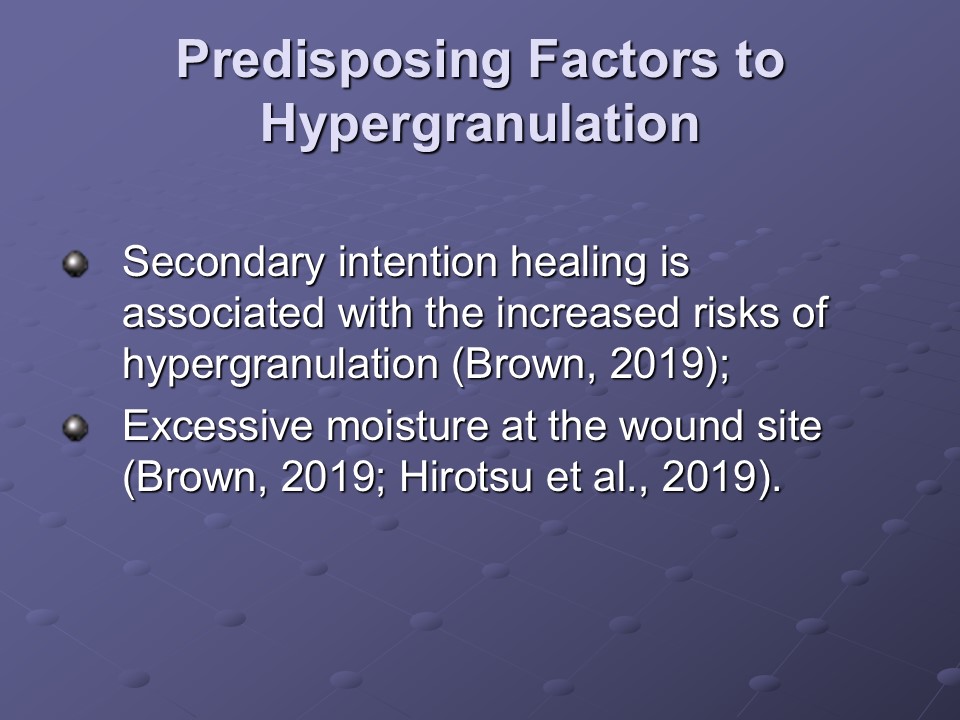

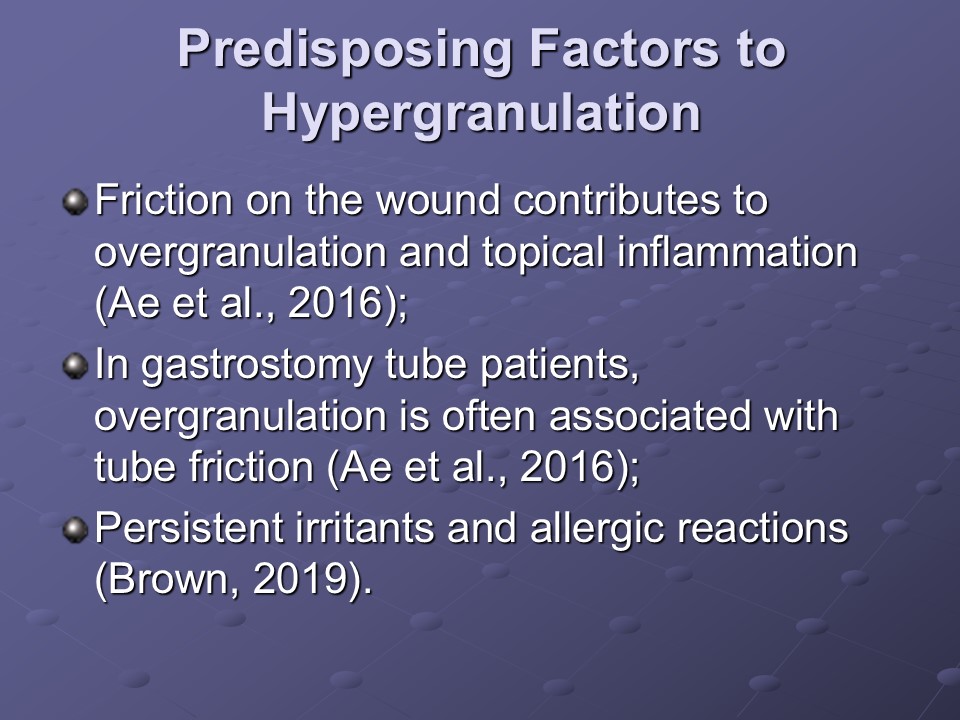
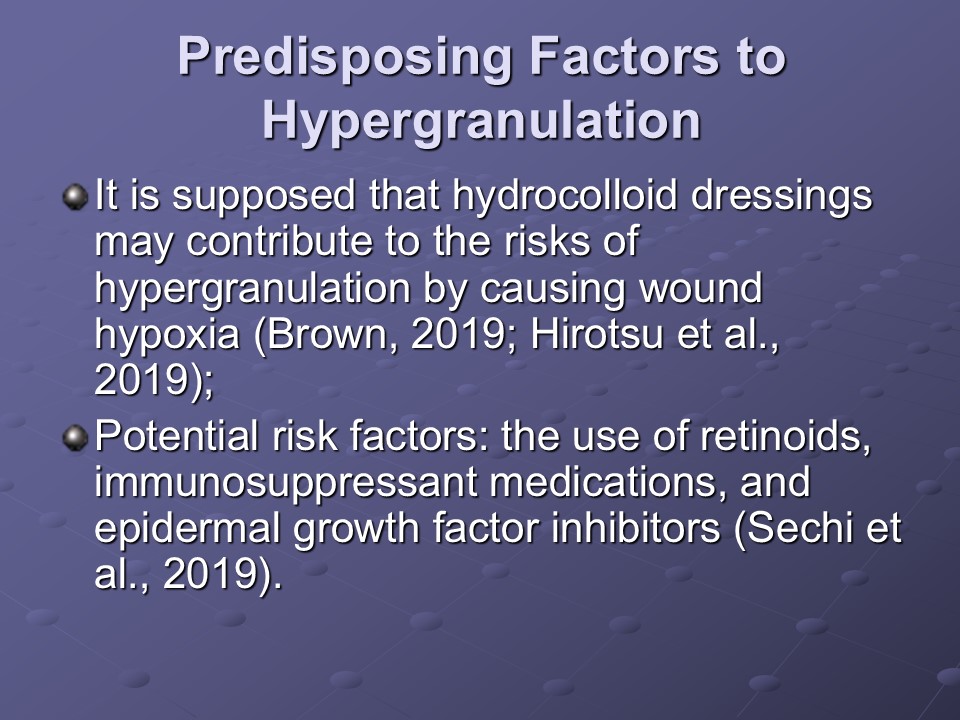
Measures to Prevent Overgranulation
Discussion questions:
- Have you ever dealt with patients with overgranulation? If so, what are your takeaways from the experience?
- What are the connections between the predisposing factors to hypergranulation and wound care skills?
Gastrostomy tube patients:
- Measures to reduce tube friction: proper anchoring to the skin and the use of skin barriers (petroleum jelly, etc.) (Ae et al., 2016; Hirotsu et al., 2019);
- Cleaning the tube site on a regular basis to prevent irritation and conducting regular peristomal skin assessments (Ae et al., 2016).
General recommendations:
- Analyzing the type and amount of wound exudate to choose appropriate wound dressings (Bast et al., 2017; Dabiri, Damstetter, & Phillips, 2016);
- Checking for the signs of infection and inflammation (Bast et al., 2017; Hirotsu et al., 2019).
Before discussing recommendations from modern literature, I would like you to reflect on your experiences and connect them with the previously mentioned information. (Give the audience about 2 minutes to reflect on the questions, then ask questions and encourage students to exchange thoughts and suggestions for about 5 minutes).
I would like to discuss what is currently known about the measures that reduce the risks of hypergranulation in hospitalized patients. To begin with, a great deal of research on overgranulation prevention is focused on gastrostomy tube patients. In such patients, hypergranulation can be prevented by using practices to minimize friction around the tube placement site; more than that, proper practices to clean the stoma contribute to the prevention of overgranulation by reducing irritation (Ae et al., 2016; Hirotsu et al., 2019). Assessments of the peristomal skin are also important to detect the signs of irritation as soon as possible.
Next, hypergranulation may occur in different types of wounds, but information on specific prevention practices depending on the type of cut or burn wounds is scarce at the present moment, so some general recommendations can be provided. First, the selection of appropriate wound dressings is of great importance (Dabiri et al., 2016). For instance, despite controversial findings regarding occlusive dressings, moisture-retentive dressings are effectively used to prevent overgranulation in dry and little exudate wounds (Bast et al., 2017). Similarly, absorptive or foam dressings can help to prevent hypergranulation in excessively moist wounds (Dabiri et al., 2016; Hirotsu et al., 2019). And, of course, strictly following the guidelines for wound assessment and infection prevention is necessary to promote patient safety and prevent multiple complications, including hypergranulation (Hirotsu et al., 2019).

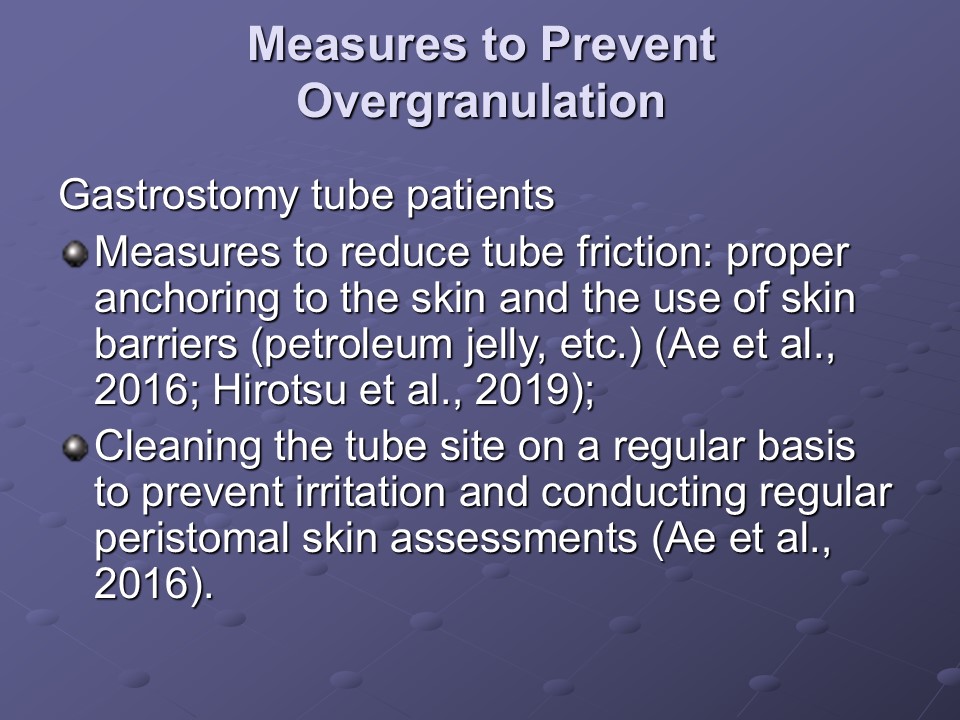
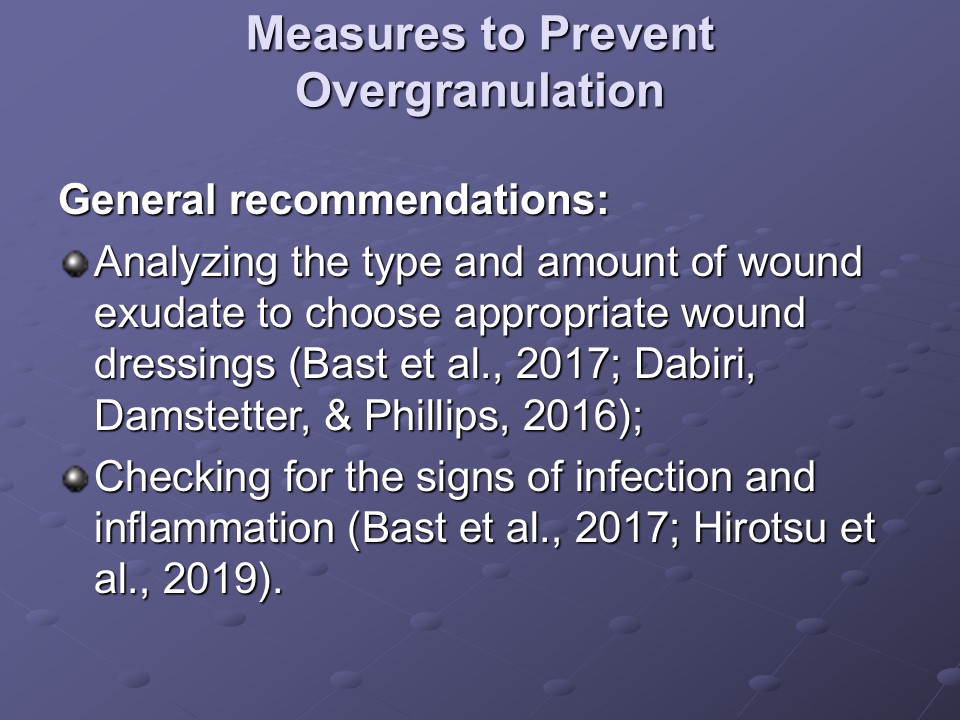
References
Ae, R., Kosami, K., & Yahata, S. (2016). Topical corticosteroid for the treatment of hypergranulation tissue at the gastrostomy tube insertion site: A case study. Ostomy Wound Management, 62(9), 52-55. Web.
Bast, F., Chadha, P., Jakharia-Shah, N., & Collier, J. (2017). Treatment of large cutaneous defects of the scalp by vacuum-assisted wound dressing. Annals of Clinical Otolaryngology, 2(3), 1-4. Web.
Brown, A. (2019). An overview of managing hypergranulation in wounds. Journal of Community Nursing, 33(3), 42-44. Web.
Dabiri, G., Damstetter, E., & Phillips, T. (2016). Choosing a wound dressing based on common wound characteristics. Advances in Wound Care, 5(1), 32-41. Web.
Hirotsu, K., Kannan, S., & Jiang, S. I. B. (2019). Treatment of hypertrophic granulation tissue. Dermatologic Surgery, 45(12), 1507-1516. Web.
Jaeger, M., Harats, M., Kornhaber, R., Aviv, U., Zerach, A., & Haik, J. (2016). Treatment of hypergranulation tissue in burn wounds with topical steroid dressings: A case series. International Medical Case Reports Journal, 9, 241-245. Web.
Prado, G., Nichols, A., & Zaiac, M. (2018). Resolution of post-surgical hypergranulation tissue with topical aluminum chloride. SKIN: The Journal of Cutaneous Medicine, 2(5), 332-335. Web.
Sechi, A., Piraccini, B. M., Alessandrini, A., Patrizi, A., Tabanelli, M., Sacchelli, L., … Savoia, F. (2019). Post-traumatic erosive dermatosis of the scalp: A hypergranulated variant. Australasian Journal of Dermatology, 60(4), e322-e326. Web.
Waldman, R. A., Lin, G., & Sloan, B. (2019). Clinical pearl: Topical timolol for refractory hypergranulation. Cutis, 104(2), 118-119. Web.